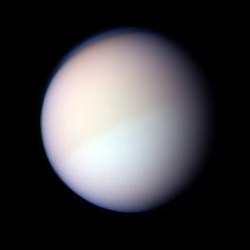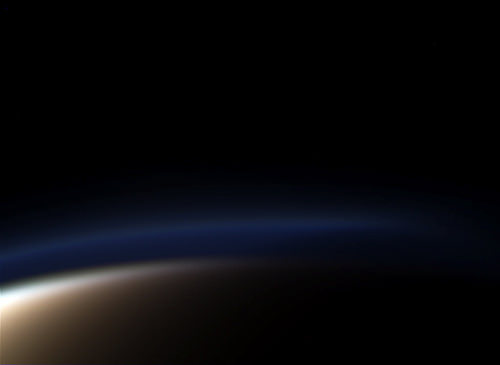[/caption]
Saturn’s moon Titan just keeps throwing surprises at us. A multi-layered atmosphere thicker than our own? Check. A hydrologic cycle that relies on methane as the operating liquid? Check. Rivers, streams and lakes filled with this same liquid? Check, check and check. And now, scientists are suspecting that Titan may have yet another surprise: a subsurface ocean.
Observations of Titan’s rotation and orbit, carried out by researchers at the Royal Observatory of Belgium using Cassini data, point at an unusual rotational inertia; that is, its resistance to changes in its motion, also known as moment of inertia or angular mass. Basically Titan moves in a way that is not indicative of a solid body of its previously assumed density and mass. Rather, its motion – both around its own axis and in its tidally-locked orbit around Saturn – are more in line with an object that isn’t uniformly solid.

According to the math, Titan may very well be filled with liquid!
Or, at least, have a liquid layer of considerable depth beneath its surface. How far below the surface, how deep and exactly what kind of liquid are all speculative at this point…it’s suggested that it may be a subsurface ocean of yet more methane. This would help answer the question of where Titan gets all of its methane in the first place; methane, – a.k.a. natural gas – is a compound that breaks down quickly in sunlight. In fact, the high-level haze that surrounds the moon like a wispy blue shell is made up of this broken-down methane. So if this stuff is raining down onto the surface in giant, frigid drops and filling streams and lakes, but is still being broken down by ultraviolet light from the Sun to enshroud the entire moon (Titan is BIG, remember…at 5,150 km – 3,200 miles – wide, it’s over a third the size of Earth!) then there has to be somewhere that this methane is coming from.
If these calculations are right, it may be coming from underground.
We propose a new Cassini state model for Titan in which we assume the presence of a liquid water ocean beneath an ice shell… with the new model, we find a closer agreement between the moment of inertia and the rotation state than for the solid case, strengthening the possibility that Titan has a subsurface ocean.
– Rose-Marie Baland et al.
Of course in order for this hypothesis to be proven many more numbers are going to have to be crunched and more data reviewed. And more possibilities considered, too; Titan’s orbital irregularities may in fact be the result of external forces, such as a close pass by a comet or other large body. Still, there’s something to be investigated here and you can bet there’ll be no shortage of attention on a problem as intriguing as this!
Titan may soon be joining the short list of moons speculated to possess subsurface oceans, alongside Jupiter’s Europa and Ganymede and sister Saturnian satellite Enceladus…and who knows how many others?
Read the article on MIT’s Physics arXiv Blog, or you can download the full report here.
Top image credit: NASA / JPL / SSI. (Edited by J. Major.)


such a fascinating moon…
This clicks in with older observations of the surface not rotating as a solid body, unless my memory fails me.
I read somewhere that the case for cryovolcanism on Titan is debated (as of today, I think). It is reasonable that an ocean could be the methane source, but an impact or other type of “fart” quite recently polluted a previous nitrogen atmosphere. Not good for biological scenarios, but interesting for planetary dynamics and climate science I would believe.
According to an article at astrophysicsspectator.com, the Huygens lander showed that Titan’s surface is largely water ice. Water ice has a density of .9 g/cc. Liquid methane has a density of .4 g/cc. If there are large subsurface methane oceans, how did a water ice surface form and stay up there?
The article suggests a methane ocean but the paper describes a water ocean. I assume that something in the water subsurface ocean could be bubbling up methane? Either biological or geological. If the surface is water ice, then I think we can assume that there must be liquid water down below. Also, does not water ice have different densities depending on temperature and pressure?